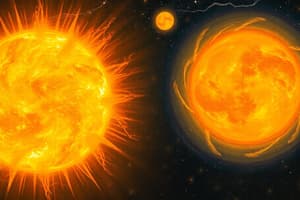Podcast
Questions and Answers
The atmosphere of Earth is composed of nitrogen (78 %), oxygen (21 %), argon (0.9 %), carbon dioxide (0.04 %) and
The atmosphere of Earth is composed of nitrogen (78 %), oxygen (21 %), argon (0.9 %), carbon dioxide (0.04 %) and
trace
An atmosphere is a layer of gas or layers of gases that envelop a planet, and is held in place by the gravity of the planetary body. A planet retains an atmosphere when the gravity is great and the temperature of the atmosphere is low. A stellar atmosphere is the outer region of a star, which includes the layers above the opaque photosphere; stars of low temperature might have outer atmospheres containing
An atmosphere is a layer of gas or layers of gases that envelop a planet, and is held in place by the gravity of the planetary body. A planet retains an atmosphere when the gravity is great and the temperature of the atmosphere is low. A stellar atmosphere is the outer region of a star, which includes the layers above the opaque photosphere; stars of low temperature might have outer atmospheres containing
compound
Most organisms use oxygen for respiration; lightning and bacteria perform nitrogen fixation to produce ammonia that is used to make nucleotides and amino acids; plants, algae, and cyanobacteria use carbon dioxide for
Most organisms use oxygen for respiration; lightning and bacteria perform nitrogen fixation to produce ammonia that is used to make nucleotides and amino acids; plants, algae, and cyanobacteria use carbon dioxide for
photosynthesis
The layered composition of the atmosphere minimises the harmful effects of sunlight, ultraviolet radiation, solar wind, and
The layered composition of the atmosphere minimises the harmful effects of sunlight, ultraviolet radiation, solar wind, and
A planet retains an atmosphere when the gravity is great and the temperature of the atmosphere is
A planet retains an atmosphere when the gravity is great and the temperature of the atmosphere is
Flashcards are hidden until you start studying
Study Notes
Atmosphere Composition
- The atmosphere of Earth is composed of 78% nitrogen, 21% oxygen, 0.9% argon, and 0.04% carbon dioxide.
Atmosphere Definition
- An atmosphere is a layer of gas or multiple layers of gases that surround a planet.
- An atmosphere is held in place by the gravity of the planetary body.
Atmosphere Retention
- A planet retains an atmosphere when the gravity is great and the temperature of the atmosphere is low.
Stellar Atmosphere
- A stellar atmosphere is the outer region of a star, including the layers above the opaque photosphere.
- Stars of low temperature can have outer atmospheres containing molecules such as water, ammonia, and methane.
Biological Importance of Atmospheric Gases
- Most organisms use oxygen for respiration.
- Nitrogen fixation by lightning and bacteria produces ammonia, which is used to make nucleotides and amino acids.
- Plants, algae, and cyanobacteria use carbon dioxide for photosynthesis.
Atmospheric Protection
- The layered composition of the atmosphere minimizes the harmful effects of sunlight, ultraviolet radiation, solar wind, and cosmic rays.
Studying That Suits You
Use AI to generate personalized quizzes and flashcards to suit your learning preferences.




